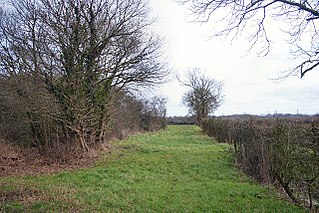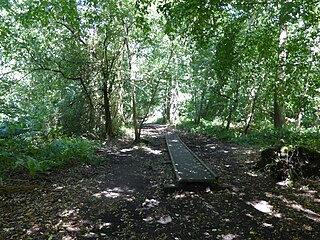
Edwardstone Woods is a 27 hectare biological Site of Special Scientific Interest near Edwardstone in Suffolk, England. It is in four areas, Park Wood with the adjacent High Wood, Cowper's Wood, Stallington Wood and Priory Down.

Honeypot Wood is a 9.5-hectare (23-acre) biological Site of Special Scientific Interest west of Dereham in Norfolk, England. It is managed by the Norfolk Wildlife Trust.

Abbey Wood, Flixton is an 18 hectare biological Site of Special Scientific Interest south—west of Bungay in Suffolk. It consists of two adjoining areas, the larger Abbey Wood to the north and the smaller Packway Wood to the south.

Burgate Wood is a 29.9-hectare (74-acre) biological Site of Special Scientific Interest in Suffolk. The site includes a medieval ringwork which is a Scheduled Monument.

Gipping Great Wood is a 25.9-hectare (64-acre) biological Site of Special Scientific Interest south of Gipping in Suffolk.

Titsal Wood, Shadingfield is a 14.7-hectare (36-acre) biological Site of Special Scientific Interest south-west of Shadingfield in Suffolk.

Westhall Wood and Meadow is a 43.1-hectare (107-acre) biological Site of Special Scientific Interest south of Rickinghall in Suffolk.

Felbrigg Woods is a 164.6-hectare (407-acre) biological Site of Special Scientific Interest south-west of Cromer in Norfolk, England. It is the main part of the grounds of Felbrigg Hall, a National Trust property which is listed on the Register of Historic Parks and Gardens of Special Historic Interest in England. It is a Nature Conservation Review site, Grade 2, and it is in the Norfolk Coast Area of Outstanding Natural Beauty.

Horse Wood, Mileham is a 7.1-hectare (18-acre) biological Site of Special Scientific Interest north-west of Dereham in Norfolk, England.

Lower Wood, Ashwellthorpe is a 37.9-hectare (94-acre) biological Site of Special Scientific Interest south-east of Wymondham in Norfolk, England. It is managed by the Norfolk Wildlife Trust.

Edgefield Little Wood is a 5.3-hectare (13-acre) biological Site of Special Scientific Interest south of Holt in Norfolk, England.

Broome Heath is a 31.7-hectare (78-acre) Local Nature Reserve in Ditchingham in Norfolk, England. It is owned by South Norfolk District Council and managed by the Broads Authority. An area in the north is designated a geological Site of Special Scientific Interest as Broome Heath Pit, and there is a Scheduled Monument in the middle.

Broome Heath Pit is a 1.2-hectare (3.0-acre) geological Site of Special Scientific Interest east of Ditchingham in Norfolk, England. It is a Geological Conservation Review site and part of Broome Heath Local Nature Reserve

Hedenham Wood is a 23.4-hectare (58-acre) biological Site of Special Scientific Interest north of Hedenham in Norfolk, England.

Sexton Wood is a 40-hectare (99-acre) biological Site of Special Scientific Interest north-west of Ditchingham in Norfolk, England. It is a Nature Conservation Review site, Grade 2.

Gawdyhall Big Wood, Harleston is a 29.8-hectare (74-acre) biological Site of Special Scientific Interest north of Harleston in Norfolk, England.

Pulham Market Big Wood is a 4.7-hectare (12-acre) biological Site of Special Scientific Interest south of Long Stratton in Norfolk, England.

Shotesham-Woodton Hornbeam Woods is a 40.4-hectare (100-acre) biological Site of Special Scientific Interest east of Newton Flotman in Norfolk, England.

Horningtoft Wood is a 8.3-hectare (21-acre) biological Site of Special Scientific Interest south of Fakenham in Norfolk, England.



















